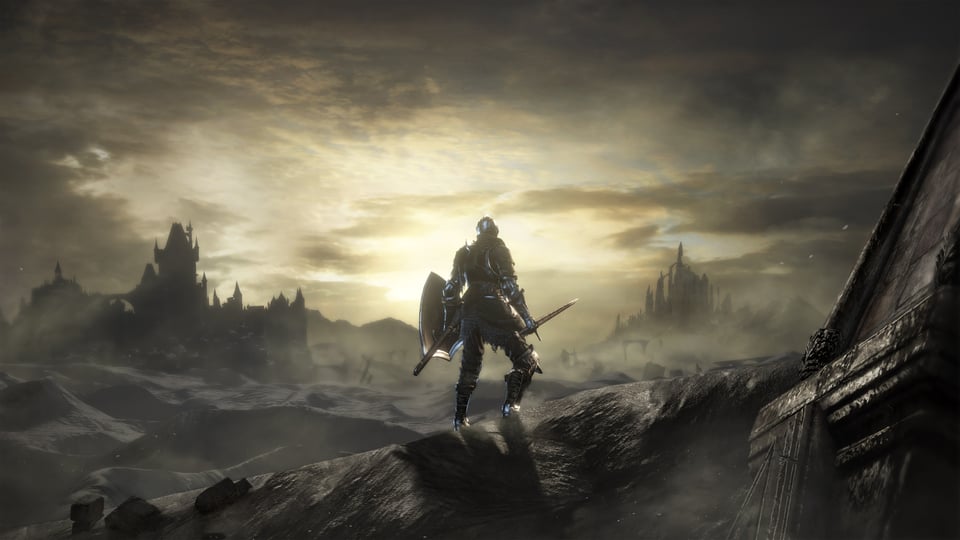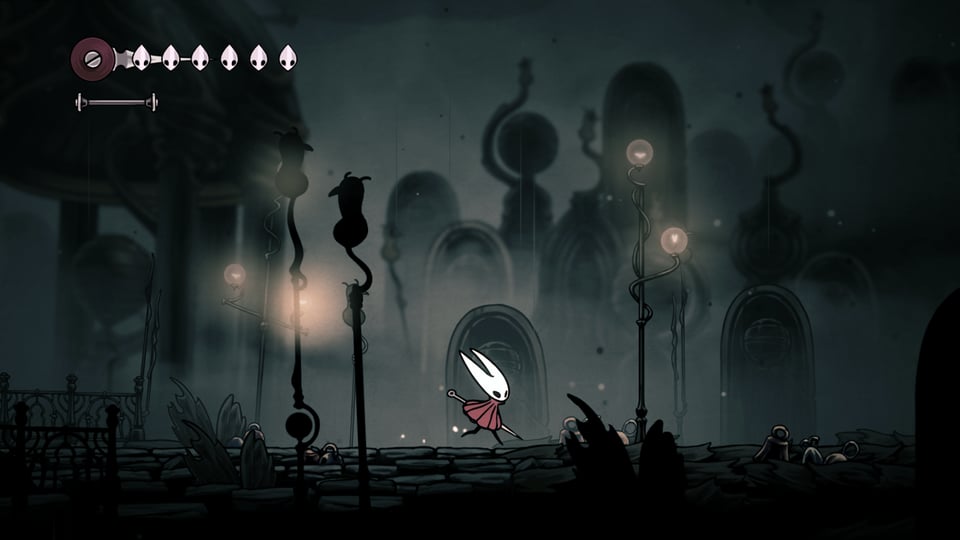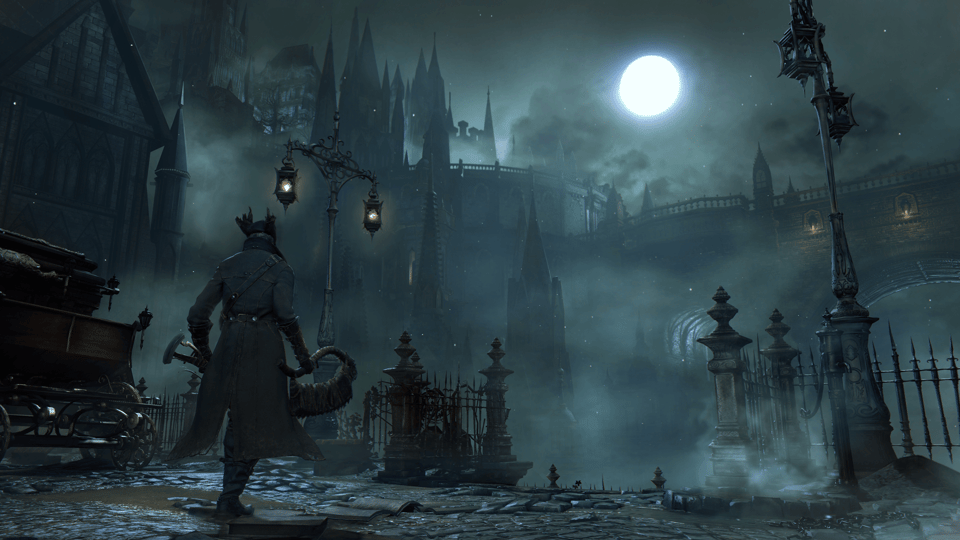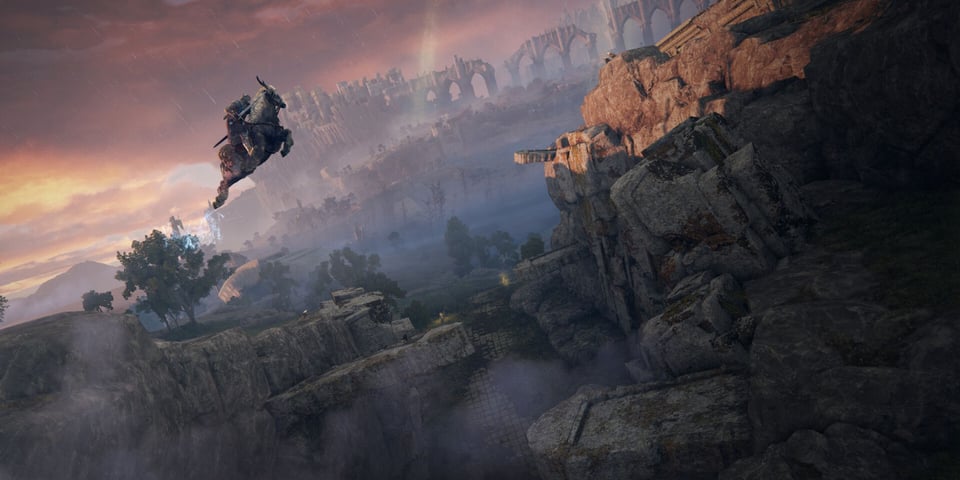Hollow Knight, Dark Souls, and the Catharsis of Post-Empire Fantasy
Because when you inhabit a crumbling empire, I guess all you want to do is stomp around one that's already crumbled.

Hollow Knight: Silksong’s release after six long years of development has brought with it a host of discourse around its many qualities. Indeed, the topic of Difficulty in Games™ is going around again in a way it hasn’t since Sekiro came out in 2019 (perhaps an interesting coincidence since Silksong was first announced the same year).
However, what I haven’t heard being discussed is the biggest thematic difference between Hollow Knight and Silksong: the question of Empire.
Dark Souls and Fallen Kingdoms
I fucking love Dark Souls. It’s unequivocally one of my all-time favorite games in—or even outside of—modern gaming, and I count Bloodborne, Demon’s Souls, and Elden Ring right there at the same level as FromSoftware’s flagship franchise. No surprise, then, that I’ve also become a big appreciator of the many things Hollow Knight does well, both from the perspective of its sparse, melancholy storytelling, and that of the mechanisms upon which it functions.

But easily the most magnetic attributes of these games for me are their post-empire settings. Until recently, I hadn’t quite put together that post-imperial fantasy was very specifically the brand that I’m into. I do typically enjoy dark fantasy more than high fantasy (hello, yes, I am a horror author), but something like The Witcher or Game of Thrones just doesn’t have the same impact that something like Dark Souls does. This is partly because of the mystery inherent to any post-imperial landscape—discovering exactly how and why that empire came to fall is usually part of the joy—but also because of the sheer amount of freedom it provides.
Thy Kingdom Come, Thy Kingdom Go
As anyone living under an authoritarian regime can tell you, the curtailing of freedoms is a real buzzkill. A code of laws naturally limits some freedom in any society (hopefully with an eye for altruism and protecting its citizens), where a fascist dictatorship specifically makes laws that hold people down, with an eye toward amassing power. But perhaps of greater concern are the innumerable ways such a government uses extrajudicial means of bribing, threatening, and committing violence to get what its leaders want. You know, the stuff most of us are far better acquainted with in 2025 than we’d probably like to be.
And so the need for the post-empire fantasy. One of the best parts of Hollow Knight is its sense of adventure and exploration. That baseline freedom, which is foundational to the whole experience, is elevated by the fact that you get to do it by traipsing through the haunted bones of a failed civilization. If you are living in a time when A. the fate of your own society is uncertain, or B. you are living in a society you are actively ashamed by, there’s something truly cathartic about stepping over the bloated corpse of a fallen empire, even if it’s not your own. It’s a much-needed reminder of impermanence and the indiscriminant, inexorable ruthlessness of history.

Silksong’s Surprising Shift
Thematically there are many important points of difference between Hollow Knight and Silksong. We’ve got a protagonist that talks, for one, and Hornet, the main character, is a stranger to the land, brought there against her will. The nameless Knight from the first game has, by contrast, come home to Hallownest, seemingly of his own volition. And despite the audiovisual similarities between both titles, there are also a handful of significant contrasts in both the visual style and the musical accompaniment.
But where Hollow Knight shows you only the bleached bones of what came before, Silksong sends you into a still-living civilization. Pharloom is certainly a decadent kingdom long into the late stages of its decline, but it lives nonetheless. If the Pale King from Hollow Knight seemed to be a benevolent (if flawed) ruler, Pharloom ended up with the short end of the stick, struggling under the weight of a decadent theocracy.
While I can’t say that Team Cherry created Silksong with these distinct differences in mind as far as the ongoing right-wing resurgence in our own world’s so-called “leadership” (though Australia is by no means exempt from this shift), I can’t imagine the game won’t strike a chord with a fair portion of its American audience given the rapid slide into fascism under the Trump regime. The far more religion-oriented themes in Silksong also feel timely (perhaps even prescient, considering its long development), despite getting far less emphasis in Hollow Knight. America is watching its empire crumble under the crepuscular flailings of a flaccid, uninspired bunch of Nazi knockoffs using a lobotomized Christianity we’re all too familiar with. Worse still, this pack of inept losers is given power only through the laziness and inattention of a languishing American public so engorged on luxury it repeatedly campaigns for its own demise. How can Silksong, Pharloom’s religious Haunting, and Hornet’s quest for the holy Citadel fail to inspire in such a time?

Horror and the Bones of Empire
While these themes may not speak to everyone in the same way, they brought my love of this very particular breed of dark fantasy to my attention. I’d played a metric ton of Dark Souls, Bloodborne, and Elden Ring, but maybe I hadn’t taken the time to consider exactly what inspired such continued fascination when it comes to their post-imperial settings. Sure, the combat is fun, the obfuscated storylines are satisfying to dissect, and the audiovisual richness is nearly unrivaled, but the unifying thread is tied simultaneously to setting and action. Wandering through the bones of dead empires, trying to suss out exactly what did them in, is the core of what gives all of these games such a distinct voice (Hollow Knight and Silksong included).
It’s also what makes each of them horror in their own ways. Certainly Bloodborne wears those horror inspirations on its sleeve while the others bring them out slowly and subtly, but each has more than its share of darkness concerning the fears and ambitions of a particular kingdom’s former rulers, few of whom survive to tell their own tales. From Hollow Knight’s Pale King, to the forsaken, eternally ambulating shell of King Vendrick in Dark Souls 2, to the the Empyrean Queen Marika and her two consorts in Elden Ring, we see the failures and thwarted ambitions of rulers sometimes well-meaning, frequently inscrutable, and always imperfect, along with how their actions shaped the downfalls of each of their respective realms.
The Post-Religion America of DIVINE APPETITES
Maybe it’s just the lost American soul in me, waiting to see exactly how and when my own empire dissolves into the dust, but I respond to this stuff like nothing else. It’s probably also, at least in part, why I’m writing DIVINE APPETITES. As a novel, it’s maybe a hair more apocalyptic than strictly post-imperial, but it scratches the same itch all the same.

A lot of my writing focuses on religion, both in terms of faith and the trauma it frequently leaves behind. I’ve written no shortage of stories that speculate about the nature of the western god Yahweh, or Jehovah, a minor god of war and storm in the ancient Levant, itself possibly born from the ashes of societal collapses of the late Bronze Age. (You might know him better as the tool of Christian nationalists trying to make your life small and miserable 3,000 or so years later; or maybe something your parents threatened you with any time you were at risk of feeling good about yourself.) DIVINE APPETITES is written along this same spectrum, bringing elements of Pure Land Buddhism to the mix. It runs the whole thing through a blender, pouring its pureed remains out in a cosmic horror akin to, if I’m being incredibly kind to myself and possibly putting aside objective reality, the work of Michael Cisco, Laird Barron, or John Langan. It’s inspired by these, at any rate.
A novel is very distinctly not a videogame, but while DIVINE APPETITES may not have afforded me the opportunity to jump on and through the bones of a dead nation in the more literal sense, the chance to play around in a post-American landscape was too good to pass up. Originally a short story about a man trapped in a bathroom, it blossomed into what it is today: a tale of disparate cultural and religious experience among American citizens of different backgrounds. Religion remains some of the most consistently fertile soil for horror with good reason; but where many horror authors and filmmakers are content to go back to the well to carry yet more water for a decrepit Christian mythology, I’m not happy unless I’m pulling it apart, rearranging it, and letting the resulting monstrosity speak to us about its component parts.
If nothing else, it’s an exploration that intrigues and sometimes comforts me. Endings are often sad, and hard truths difficult to stomach, but both can bring catharsis if we let them. Dark Souls taught us this lesson well, and I’m very glad that to see that Hollow Knight and Silksong continue to pull it into the popular consciousness.
Now if you’ll excuse me, I have to go back to exploring Pharloom. I have more than a few secrets left to uncover, and if I’m lucky, maybe a few gods to kill.